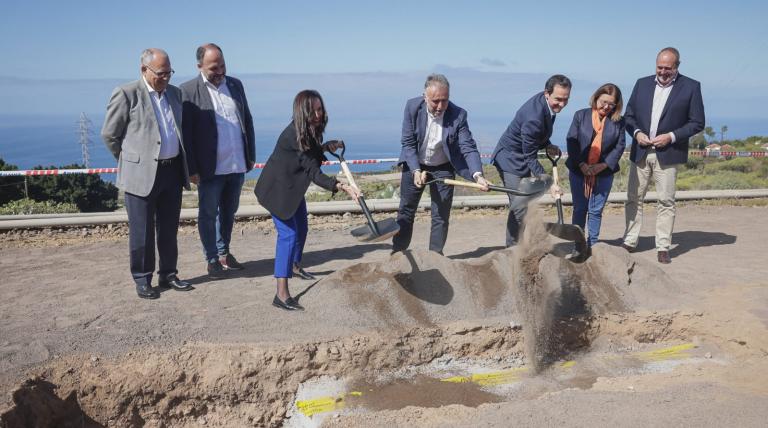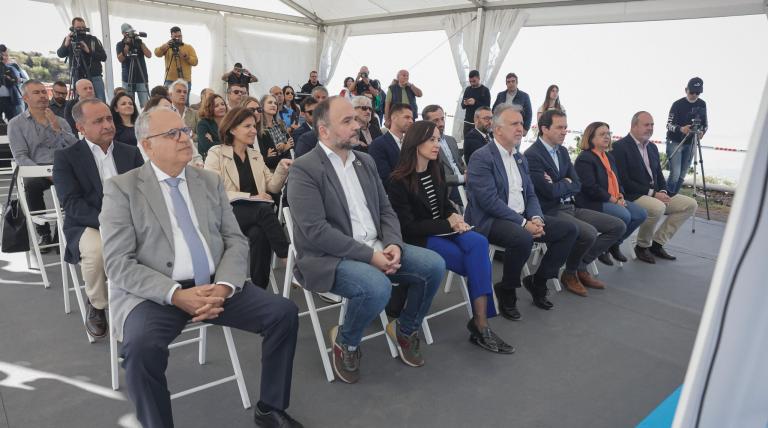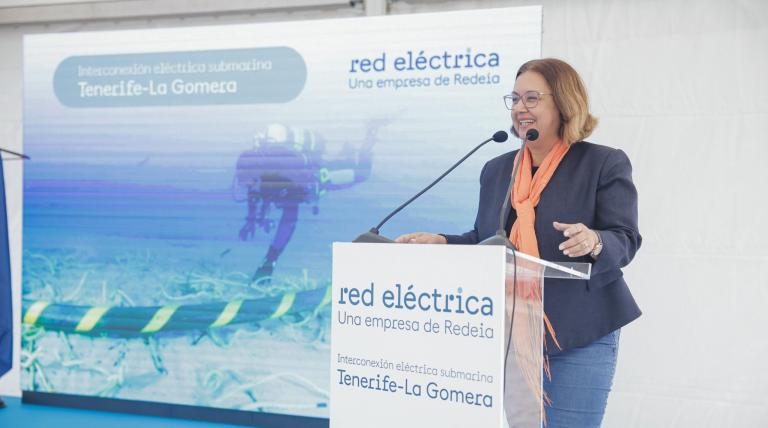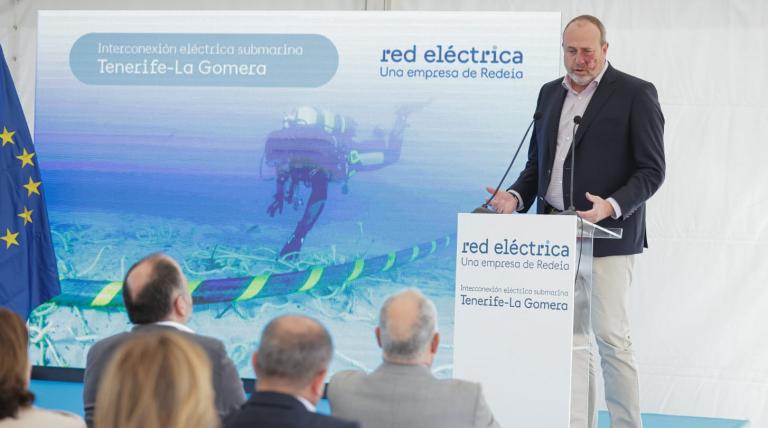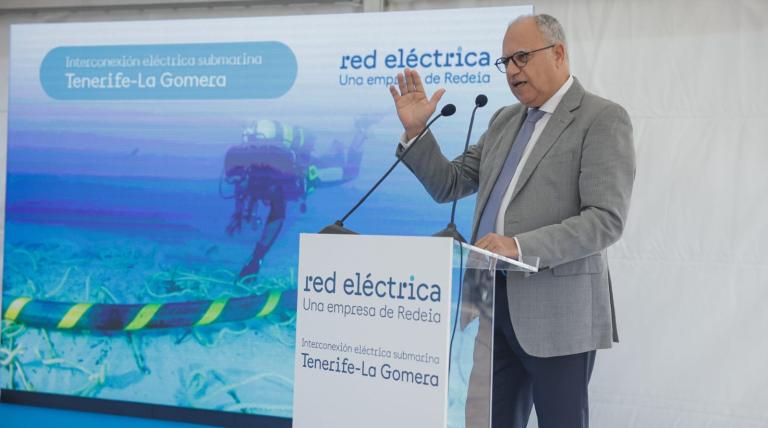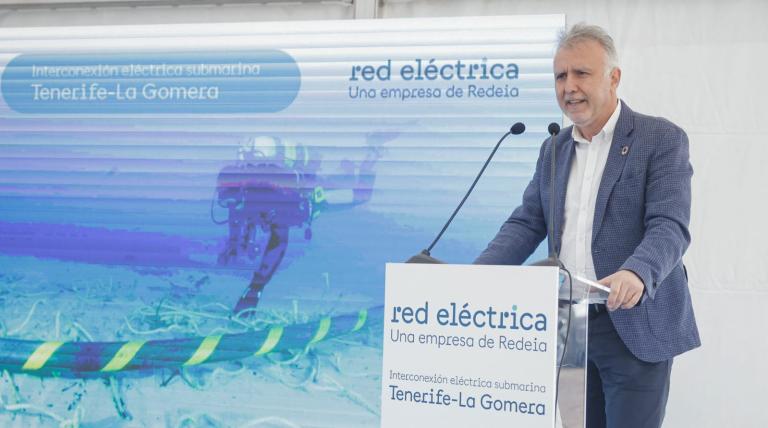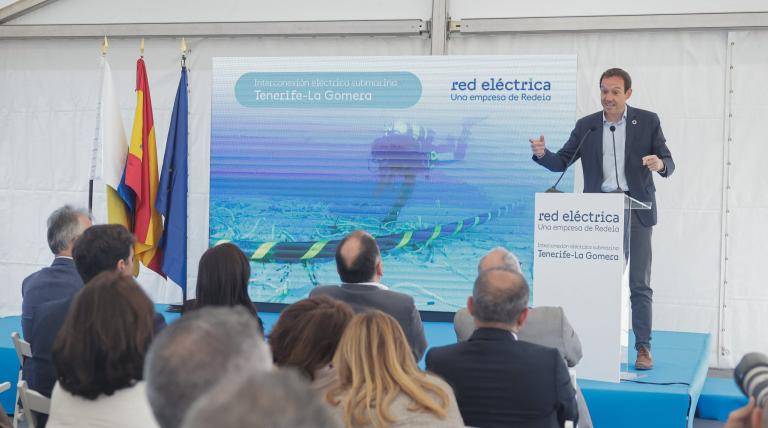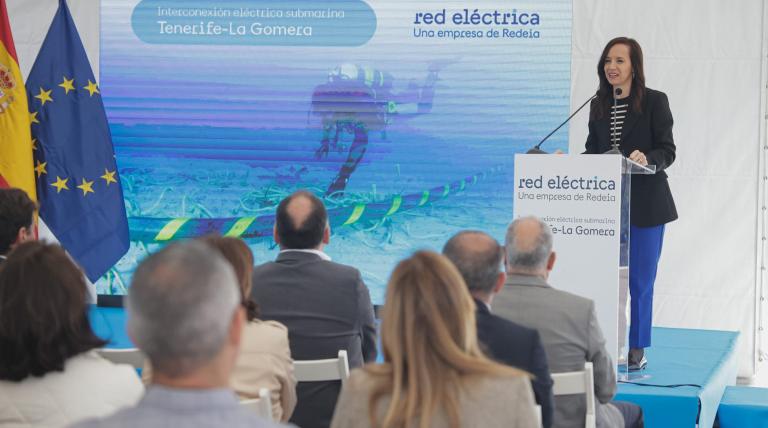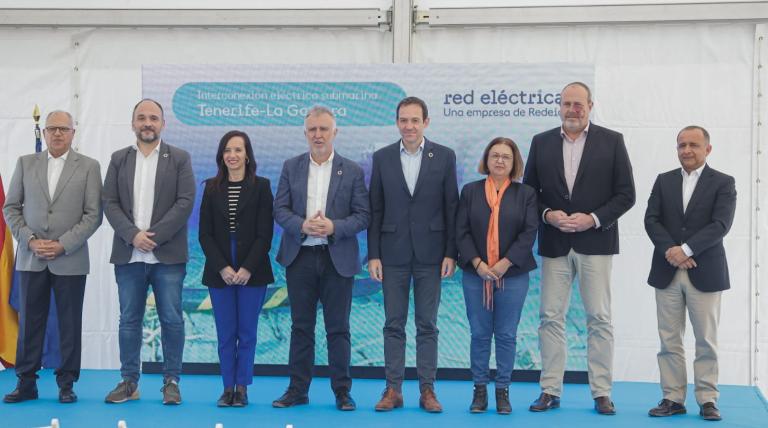For 40 years, we've been driving our country's economic and social progress. Four decades shaping Spain.
Red Eléctrica starts work on the new subsea electricity link between Tenerife and La Gomera
- This infrastructure will contribute to helping the electricity system of La Gomera meet the Island’s decarbonisation target and promote greater integration of renewable energy into the power systems of both islands, thus guaranteeing greater energy autonomy and security for the Canary Islands system as a whole.
- This is a project of great technical complexity, as it is the deepest HVAC double circuit three-core submarine link in the world, and for which, every aspect of the project has been adapted to the reality of the territory from all points of view.
- The event, held at the site of the future Chío substation (Tenerife), was presided over by the Regional Governor of the Canary Islands, Ángel Víctor Torres, and was attended by the Chairwoman of Redeia, Beatriz Corredor, and the Commissioner for the Promotion of Sustainable Energy in Island Systems, Marc Pons, as well as other authorities from the island and local councils.
Red Eléctrica, a subsidiary of Redeia responsible for the transmission of electricity and the operation of the national electricity system, has started work on the new subsea link between Tenerife and La Gomera. A new inter-island link that will be decisive in guaranteeing the security of supply in La Gomera, enabling greater integration of renewable energy and achieving a reduction in overall generation costs by connecting the power systems of both islands.
Thanks to this new link, which is scheduled to be commissioned in 2025, La Gomera will be able to generate and integrate a higher share of renewable energy into the island's total generation mix/demand, thus reducing dependence on the El Palmar thermal power station. Furthermore, thanks to the link, the Tenerife system will be able to integrate the surplus renewable generation of La Gomera, thus reducing its dependence on fossil fuels and contributing to the reduction of greenhouse gas emissions.
The project, therefore, represents a firm step in the green transition process in the Canary Islands, which aims to reach the full decarbonisation of its economy by 2040, ten years ahead of the targets set by Europe.
The inauguration ceremony to mark the start of the construction works related to this project was held in the area where the new Chío substation is to be built (Guía de Isora, Tenerife) and was attended by the President of the Canary Islands, Ángel Victor Torres; the Chairwoman of Redeia, Beatriz Corredor; the Commissioner for the Promotion of Sustainable Energy in Island Systems, Marc Pons; the President of the Island Council of La Gomera, Casimiro Curbelo, the first Vice-President of the Island Council of Tenerife, Enrique Arriaga, and the Mayoress of Guía de Isora, Josefa Mesa, among other dignitaries.
"A great boost is being given to the energy transition in the Canary Islands", stated Mr. Torres.
In his speech, the President of the Canary Islands, Ángel Víctor Torres, referred to the fact that, with this project, fruit of a collaborative effort among the Island’s Public Administrations and Redeia, "a great boost is given to the energy transition in the islands and a commitment is made to the green transformation and decarbonisation of the Canary Islands". This plan "is a key element in the energy transition that we want for the archipelago and is also part of the European and national ambition to decarbonise the economy, all of which are included in the Canary Islands Sustainable Development Strategy".
Mr. Torres explained that "the subsea electricity link between La Gomera and Tenerife [which is in addition to the existing one between Lanzarote and Fuerteventura] will facilitate the reduction of electricity generation costs and will contribute to reducing dependence on fossil fuels from abroad, while at the same time having a positive environmental improvement on both islands". This initiative in turn contributes to further progressing the increased participation of renewable energy in the Canary Islands' electricity generation mix, which, in this legislature, from the end of 2018 to 2022, has gone from representing 10.52% to 20.13%, which means that the contribution of clean energy in the Canary Islands' energy mix has almost doubled. One-fifth of electricity consumption in the islands already comes from green, renewable, sustainable sources", stressed the President of the Canary Islands.
The Chairwoman of Redeia, Beatriz Corredor, highlighted the importance of this infrastructure because of "its decisive role in advancing the green transition, and which is of critical importance for isolated systems such as the Canary Islands, where energy autonomy is a guarantee of security of supply for the system as a whole". In this regard, she highlighted the strategic role that Red Eléctrica is playing in this process in the islands: "our commitment to the society of the Canary Islands is firm and long-lasting, as we have demonstrated with projects of enormous strategic importance such as the subsea link between Lanzarote and Fuerteventura or the Chira-Soria pumped-storage hydroelectric power station".
Redeia’s Chairwoman also wished to highlight the close-knit relationship existing with the institutions, organisations and administrations of the Canary Islands, both in the process regarding the permitting authorisations of essential projects and in joint actions aimed at ensuring that "the activity of Red Eléctrica in these islands generates a positive impact on the population". Furthermore, Ms. Corredor highlighted projects of great social and environmental value in which the Company participates, such as the renewed agreement for the prevention of fires; reforestation projects such as that of Chajaña (located within the Corona Forestal Natural Park) or the preparation of the Manual regarding actions that address the conservation of wildlife in Tenerife.
The Commissioner for the Promotion of Sustainable Energy in Island Systems, Marc Pons, said that "the Spanish Government wants to turn the archipelagos into the spearheads of the decarbonisation effort of our country. Territories in which the promotion of public-private initiatives can be replicated on the mainland, with the aim of accelerating an energy transition that Spain is leading at a European level, and which cannot be reversed". He added that "in order to achieve this goal, it is essential to understand the singularities of the islands when defining specific strategies and actions that bear in mind the various aspects associated with institutional agreement". According to Mr. Pons, a perfect example of this are "the PRTRs (Recovery, Transformation and Resilience Plans), which are funds that contemplate investments of some 700 million euros focused exclusively on promoting actions that accelerate the energy transition of our islands. In addition to the foregoing, we mustn’t forget the nearly 2 billion euros encompassed in the Red Eléctrica's current transmission grid planning in the Canary Islands and Balearic Islands that seek to strengthen the transmission grid meshing and thus raise the bar regarding guarantee and quality of supply on the islands".
For his part, the President of the Island Council of La Gomera, Casimiro Curbelo, stressed that the start of the project brings the island closer to achieving the objectives set in terms of the energy transition. The President added that the island is working on promoting the implementation of renewable energy and providing greater security to its current energy supply system. In this regard, he pointed out that, with the commissioning of the five wind farms next week, it will be possible to generate more energy than the island currently consumes and, as a result of the installation of the electricity link, it will be possible to transfer this surplus to Tenerife.
The First Vice-President and Regional Minister for Innovation of the Island Council of Tenerife, Enrique Arriaga, highlighted "the effort that the public administrations and companies involved have been making in recent years to reduce the carbon footprint" and valued the work that Red Eléctrica is now undertaking. "Leaving a more sustainable planet and with fewer emissions is a duty that all politicians should undertake regarding our society and we must contribute tirelessly to achieve this, and, for this reason, we must not only incorporate green energy but also promote research in this area".
The Mayoress of Guía de Isora, Ms. Josefa Mesa, stressed "that the future lies in projects like this one, which are committed to sustainability, and which will benefit the inhabitants of both islands and, therefore, the municipality of Guía de Isora, by promoting the use of renewable energy and by providing a systemin the long term which will reduce the overall costs of electricity generation".
A technical challenge adapted to the local territory
This new strategic project is an ambitious challenge, given its technical complexity in both its terrestrial and subsea sections. No standard solutions have been applied, as each of them has been flexibly adapted to the reality of the territory from all points of view: social, technical and environmental.
The axis consists of a 66 kV double-circuit line, with a 36 km subsea section and two buried land sections (one on the island of La Gomera and the other on the island of Tenerife), which will connect the future electricity substation of Chío (Tenerife) with the new electricity substation of El Palmar (La Gomera).
This is the deepest HVAC double circuit three-core submarine link in the world, which is why it has required an adapted cable design, reinforced with light materials capable of withstanding the demanding requirements of the environment in which the cable will be installed.
On the other hand, due to its length and complexity, the way the cable lands on both islands has posed a challenge to ensure the protection of the biodiversity of the shallowest waters, given the singular nature of the volcanic terrain, which is very heterogeneous. To this end, the Horizontal directional drilling technique was used for the sea-coast approach of the link, which introduces the cable into the seabed through a microchannel with exit hundreds of metres from the coast, eliminating any impact on the biological communities of the coastal section where the drilling takes place.
In short, the route of the inter-island link has been designed to minimise the potential impact on the landscape and to ensure maximum protection of the flora and fauna in the areas in the vicinity of the route of the link.





















